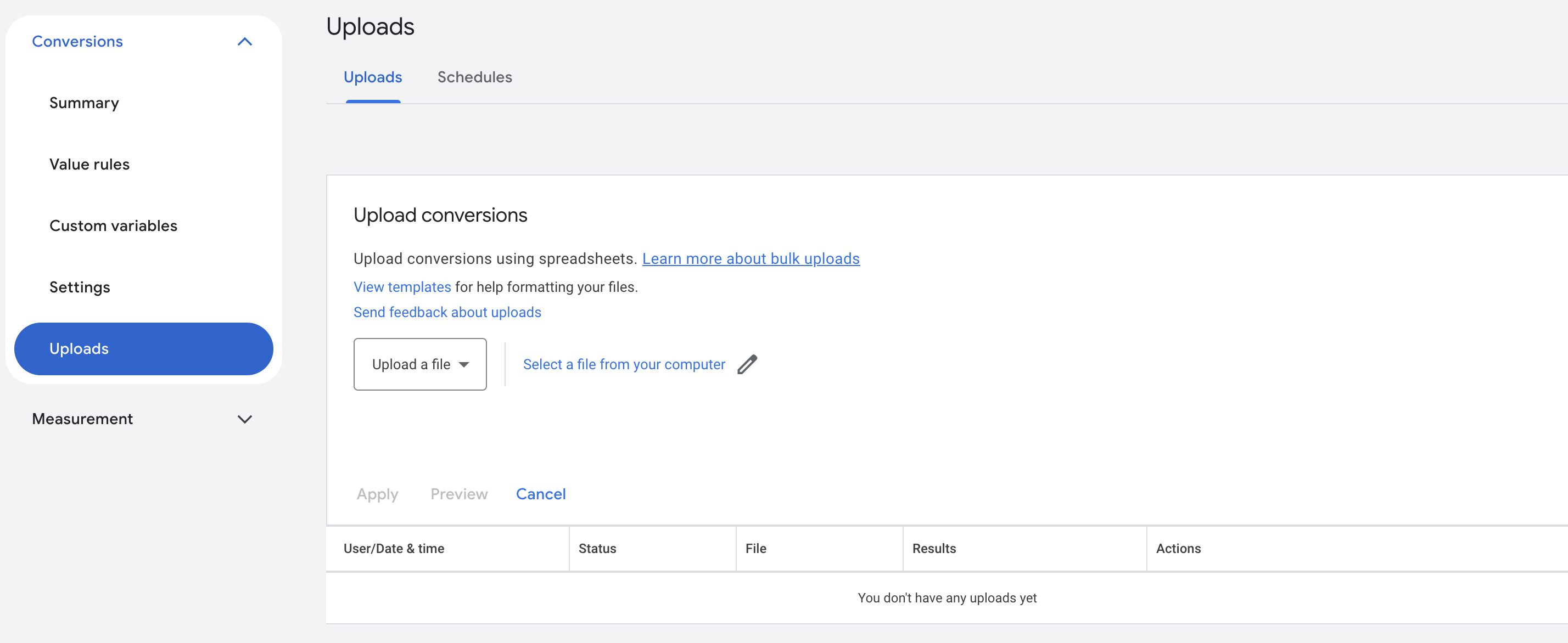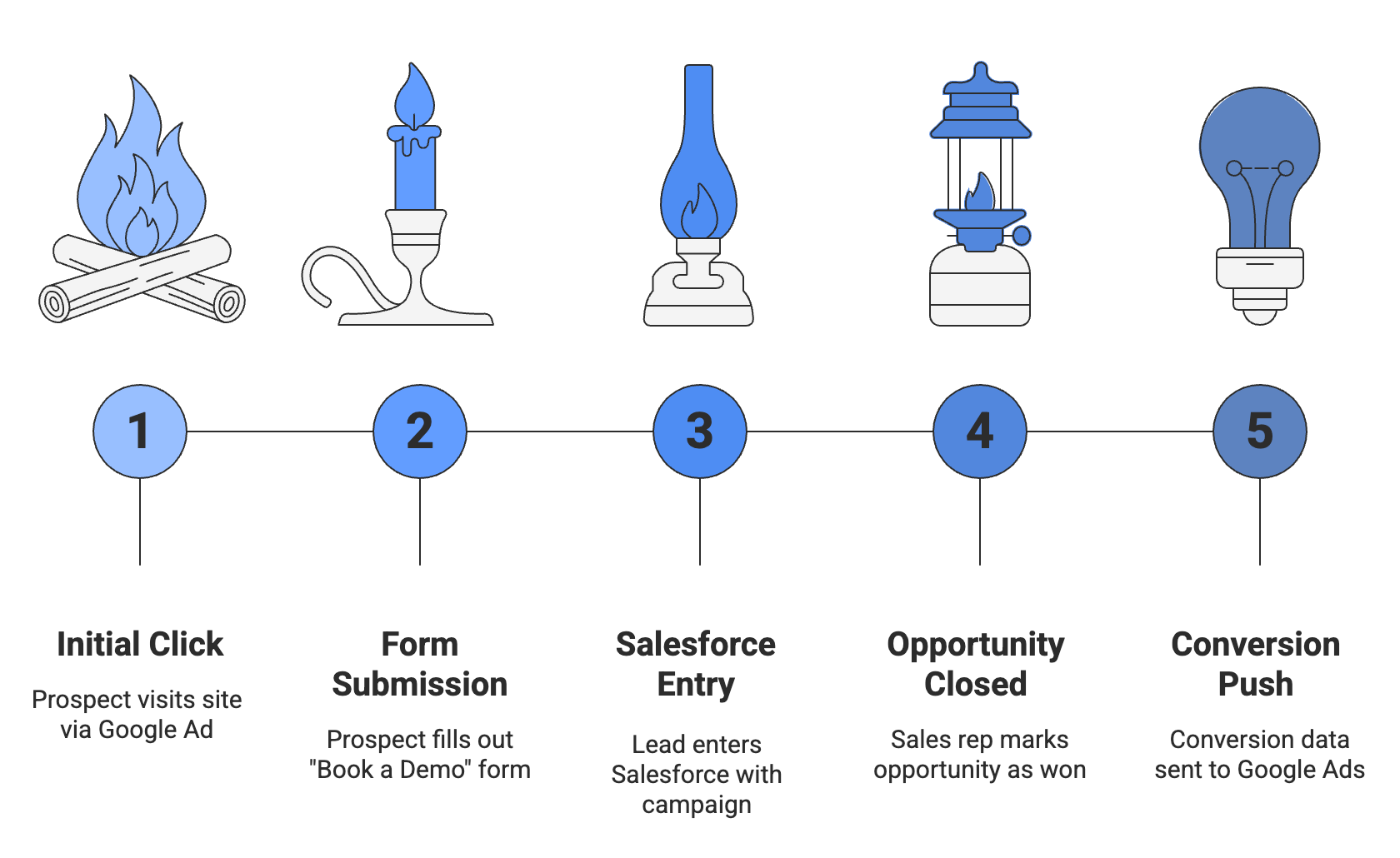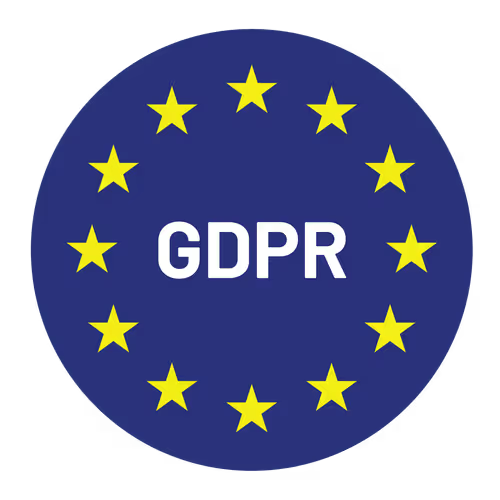Read time :
How to Set-up Offline Conversion Tracking With Google Ads : A Complete 2025 Guide to Bridging Clicks and Real-World Sales
Connect Google Ads to Salesforce with offline conversion tracking. Capture GCLIDs, sync CRM data, and attribute real revenue to your campaigns

What is Offline Conversion Tracking?
Offline conversion tracking is the process of attributing marketing campaigns, especially paid ads, to sales or actions that happen outside the digital channels. These may include:
- Phone sales
- In-person purchases
- Signed contracts
- Sales meetings booked outside the website
By capturing unique identifiers, such as GCLID, and syncing with CRM or POS systems, marketers can create a feedback loop by sending these offline outcomes back to ad platforms to optimize campaigns basedon real revenue, rather than just clicks or form submissions.
Why Offline Conversion Tracking is Essential
While SEO and paid media continue to drive website traffic and leads, the biggest challenge for performance marketers remains connecting online engagements to offline sales.
Traditional conversion tracking stops at the last click or an eventual form fill. But what about when a lead signs a contract after a call, books a demo offline, or makes a purchase in-store? That's where offline conversion tracking comes into play.
Offline conversion tracking with Google Ads enables you to close the loop, aligning your ad spend with actual revenue, allowing you to move beyond reporting just on leads generated.
ROI transparency is king in every organization, and ensuring your team can track where offline revenue comes from and further enhance your online campaigns, as well as more accurately report on revenue sources, is essential for marketers and SEO strategists alike.
Offline Conversions and SEO: Why It Matters for Organic Strategy Too
Offline tracking is often associated with paid media, but it also has a massive impact on your SEO strategy. Knowing which content leads to real-world conversions helps you prioritize high-value keywords and optimize your editorial calendar.
Benefits for SEO:
- Attribute leads from blog articles or organic pages that result in offline sales.
- Identify high-converting search intents.
- Align SEO performance with pipeline and revenue, not just pageviews.
Offline insights provide your SEO team with the data they need to drive not just traffic, but also sales-qualified leads that lead to revenue.
How Offline Conversion Tracking Works in Google Ads
Offline conversion tracking connects Google Ads engagements to real-world actions through unique click identifiers and synced data uploads.
Key Concepts:
- GCLID (Google Click ID): A unique identifier appended to each ad click.
- Data Flow: Click on an ad → lead fills out a form (GCLID captured) → CRM logs lead → sale happens offline → conversion uploaded back to Google Ads.
- Upload Options: Manual CSV uploads or automated API integrations.
- Enhanced Conversions for Leads (ECL): Privacy-safe alternative when GCLID isn't available.
By syncing your CRM with Google Ads, you can ensure that you're not just tracking clicks, but also going the extra mile and measuring closed deals.
How to Set Up Manual Offline Conversion Tracking in Google Ads
If you're not ready for API automation, you can use Google Ads' manual CSV upload method to track offline conversions.
Steps:
- Capture the GCLID when someone submits a lead form on your site.
- Store the GCLID in your CRM associated with the lead.
- Create a conversion action in Google Ads (see next section).
- Export a CSV file with the required format: Google Click ID, Conversion Name, Conversion Time, Conversion Value.
- Go to Google Ads > Goals > Conversions > Uploads.
- Upload your CSV file and review matching results.

This method helps attribute offline actions to specific campaigns and keywords even without full automation.
Creating or Importing Conversion Actions in Google Ads
Before uploading offline conversions, you must create a corresponding conversion action in your Google Ads account.
How to Create a Conversion Action:
- Go to Tools & Settings > Conversions.
- Click the + New conversion action button.
- Choose Import as the source.
- Select Other data sources or CRMs and choose "Track conversions from clicks."
- Set up your conversion details:
- Name (e.g. "Offline Deal Closed")
- Category (e.g. Purchase or Lead)
- Value, Count, and Attribution settings
- Save the conversion action. You can now start uploading matching conversions.

Ensure that the conversion name in your CSV matches the one defined here precisely.
CRM Integration for Offline Conversion Tracking
Your CRM is where leads turn into opportunities and deals are finalized. Connecting your CRM with Google Ads is essential for tracking offline conversions.
Key Actions:
- Capture and store GCLID in your CRM when a form is submitted.
- Create custom fields to track lead stage and conversion status.
- Use tools like Zapier, Heeet.io, or Salesforce native integrations to push conversion data.
- Match leads using email, phone number, or click ID.
This CRM-to-Google Ads connection turns your surface-level ad reporting into revenue-driven insights.
Best Practices for Tracking Offline Conversions Like a Pro
To avoid lost data and imprecise attribution, it's crucial to use best practices from the get-go.
Checklist:
- Always store GCLID in form submissions.
- Create a CRM workflow to update conversion status.
- Upload conversions regularly (daily, hourly, or near real-time).
- Set up naming conventions for leads and conversions.
- Keep within Google’s upload window (usually 90 days).
- Ensure user privacy and GDPR compliance.
These minor operational tweaks can significantly impact your offline tracking accuracy.
Why Automating CRM-to-Google Ads Conversion Uploads Is Better
Manual uploads can work, but automating the sync between your CRM and Google Ads is the most efficient and reliable approach for several reasons:
Benefits of Automation:
- Saves time and reduces errors: No need to manually export, format, and upload CSVs.
- Real-time or scheduled updates: Send conversion data automatically as deals close or stages change.
- Improves campaign optimization: Google Ads utilizes conversion data to adjust bidding and targeting more efficiently and quicker than you can.
- Scales with volume: Whether you close 10 or 10,000 deals a month, automated pipelines handle it effortlessly.
- Ensures consistency: Automated workflows prevent mismatches and formatting issues that can cause rejected conversions.
Platforms like Heeet.io or Zapier can streamline this setup, making full-funnel attribution accurate and always up-to-date.
Your CRM is where leads are converted into the sales pipeline and deals are closed. Connecting your CRM with Google Ads is the key to offline conversion tracking.
Key Actions:
- Capture and store GCLID in your CRM when a form is submitted. (automatically done with Heeet.io)
- Create custom fields to track lead stage and conversion status.
- Use tools like Zapier or Heeet.io to push conversion data.
- Match leads using email addresses, phone numbers, or click IDs.
This CRM-to-Google Ads connection transforms your ad reporting from surface-level metrics to revenue-driven insights.
Case Study Example: From Click to Closed Deal
- Prospect clicks on a Google Ad and visits your site.
- They fill out a "Book a Demo" form. GCLID is stored.
- Lead enters Salesforce with associated campaign.
- Sales rep marks the opportunity as "Closed Won."
- Conversion is pushed back to Google Ads via Heeet.io.
- The ad campaign is credited with securing a $15K deal.

This kind of end-to-end visibility is what enables marketers to double down on what works.
Stay Ahead by Connecting Every Click to Revenue
Offline conversion tracking with Google Ads isn't just a technical upgrade, it’s a strategic advantage. Brands that thrive are the ones that can prove the value of every marketing dollar. By syncing your CRM, capturing GCLIDs, and uploading closed deals, you turn guesswork into precision.
Whether you're in paid acquisition, SEO, or customer success, showing the connection between touchpoints and finding revenue clarity helps your organization see the difference campaigns are making, so you can justify your spend.
Are you capturing GCLIDs? Is your CRM feeding back to your ad platforms? If not, it's time to see how tools like Heeet.io get your full-funnel tracking in place.
Don’t just measure clicks. Measure what closes. Book a demo now !
.svg)
Ready to track prospects from lead to close with Heeet?
Heeet gives marketers and sales professionals at IT & Security firms turn geuss work intro informed decisions that drive revenue while meeting the same secruity technical standards you provide your clients.





